Best Off-Road Bikes in India: Exploring Thrilling Adventures
Last Modified: 10-January-2025

The best off-road bikes deliver the perfect combination of adventure and adrenaline, allowing riders to conquer rugged trails, rocky slopes, and dense forests with ease. Engineered to master the most challenging terrains, off-road bikes in India have evolved from being niche recreational gear to essential equipment for thrill-seekers. Whether you’re a seasoned enthusiast or a beginner, exploring the best off-road mountain bike ensures a reliable and exhilarating experience, all while keeping the off-road bike price in mind for a budget-conscious yet high-performance choice.
18 Best Off-Road Bikes in India in 2025
Off-road bikes are designed to handle all types of trails—from rocky paths to mud-filled tracks and even shallow rivers. These bikes are equipped with robust wheels and advanced suspension systems to absorb impacts during challenging rides. They also feature powerful engines, providing excellent torque and power, which helps the rider conquer rugged terrains with ease.
When shopping for off-road bikes in India, you’ll find several high-performance options that are available at a low price without sacrificing quality. The best off-road bike offers impressive durability, handling, and suspension features, ensuring a smoother ride on difficult terrains. For those on a budget, there are plenty of off-road bikes under 2 Lakh that deliver remarkable performance.
If you’re a beginner, exploring the world of offroading bikes can be an exciting yet challenging adventure. Many riders opt for off-road mountain bikes designed specifically for hilly terrains. Let’s explore the best off-road bikes in India.
Read More : Top 5 Suzuki Bikes In India With Prices
List of 18 Best Off-Road Bikes in India in 2025
| Model Name | Ex-showroom Price | Mileage (km/l) |
| Hero XPulse 200T 4V | Rs. 1.41 Lakh | 35-40 |
| Suzuki V-Strom SX 250 | Rs. 2.11 Lakh | 25-30 |
| Yezdi Scrambler | Rs. 2.09 Lakh | 25-30 |
| Yezdi Adventure | Rs. 2.09 Lakh | 25-30 |
| KTM 250 Adventure | Rs. 2.40 Lakh | 30-35 |
| Triumph Scrambler 400 X | Rs. 5.15 Lakh | 20-25 |
| KTM 390 Adventure X | Rs. 2.85 Lakh | 28-35 |
| Royal Enfield Himalayan 450 | Rs. 2.90 Lakh | 30-35 |
| Benelli TRK 251 | Rs. 2.50 Lakh | 22-28 |
| BMW G 310 GS | Rs. 3.10 Lakh | 30-35 |
| KTM 390 Adventure | Rs. 3.40 Lakh | 25-30 |
| Kawasaki KLX 140 | Rs. 4.30 Lakh | 30-35 |
| Honda CB500X | Rs. 6.99 Lakh | 20-25 |
| Kawasaki Versys 650 | Rs. 7.09 Lakh | 20-25 |
| Honda CRF1100L Africa Twin | Rs. 14.50 Lakh | 15-20 |
| Triumph Tiger 1200 | Rs. 16.99 Lakh | 18-22 |
| BMW R 1300 GS | Rs. 22.00 Lakh | 15-20 |
| Ducati Multistrada | Rs. 18.00 Lakh | 15-18 |
1. Hero XPulse 200T 4V
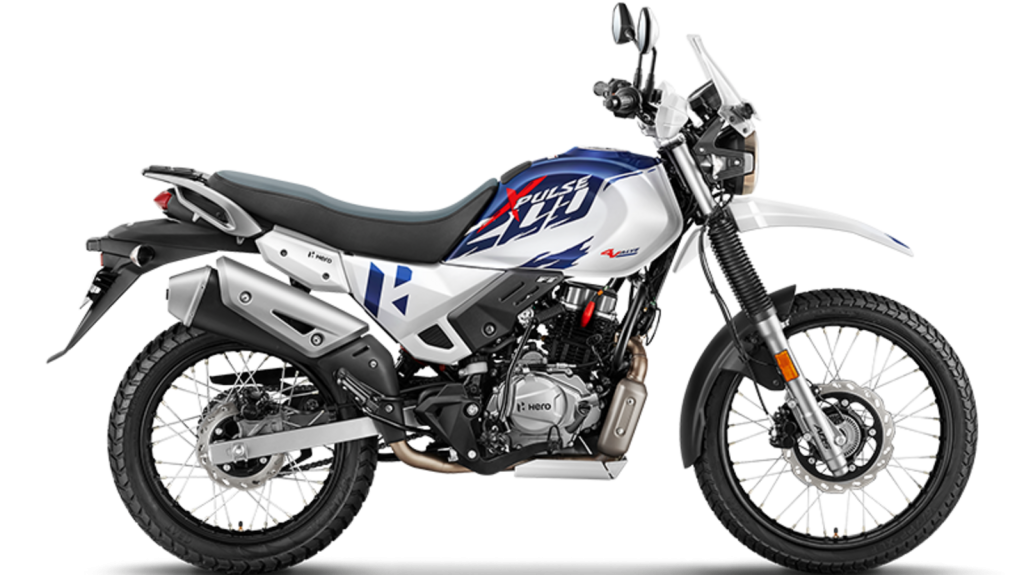
The Hero XPulse 200T 4V is a popular choice among riders, offering an affordable yet powerful option for those new to off-roading. It’s an ideal pick for those searching for off-road bikes in India at a low price, without compromising on performance. With its reliable features and solid performance, the XPulse 200T 4V ensures a satisfying off-roading experience for beginners and enthusiasts alike.
| Specifications | Details |
| Engine | 200cc, Air-cooled, Single Cylinder |
| Power | 18.08 bhp @ 8,000 rpm |
| Torque | 16.45 Nm @ 6,500 rpm |
| Fuel Tank Capacity | 13 Litres |
| Mileage | 35-40 km/l |
| Front Suspension | Telescopic fork |
| Rear Suspension | Monoshock |
| Front Brake | Disc Brake, 276mm |
| Rear Brake | Disc Brake, 220mm |
| Price | Rs. 1.41 Lakh |
2. Suzuki V-Strom SX 250
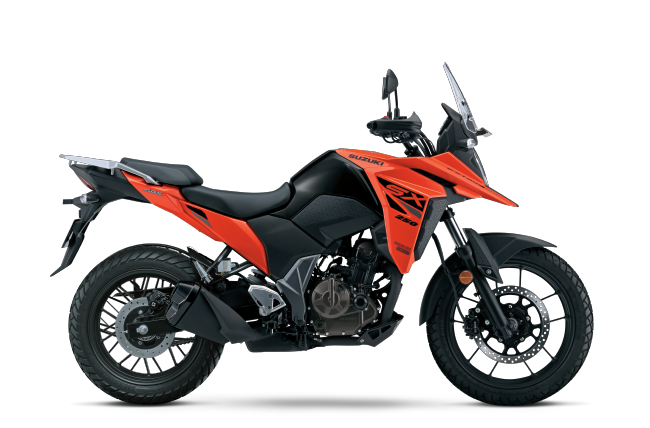
The Suzuki V-Strom SX 250 is a reliable choice for serious off-road riders. Known for its durability and performance, it is regarded as one of the best off-road bikes. It is preferred for long and challenging rides, making it an excellent choice for adventurous riders.
| Specifications | Details |
| Engine | 249cc, Single Cylinder, Liquid-cooled |
| Power | 26.1 bhp @ 9,300 rpm |
| Torque | 22.2 Nm @ 6,500 rpm |
| Fuel Tank Capacity | 12 Litres |
| Mileage | 25-30 km/l |
| Front Suspension | Telescopic Fork |
| Rear Suspension | Mono-shock |
| Front Brake | Disc Brake, 300mm |
| Rear Brake | Disc Brake, 240mm |
| Price | Rs. 2.11 Lakh |
3. Yezdi Scrambler
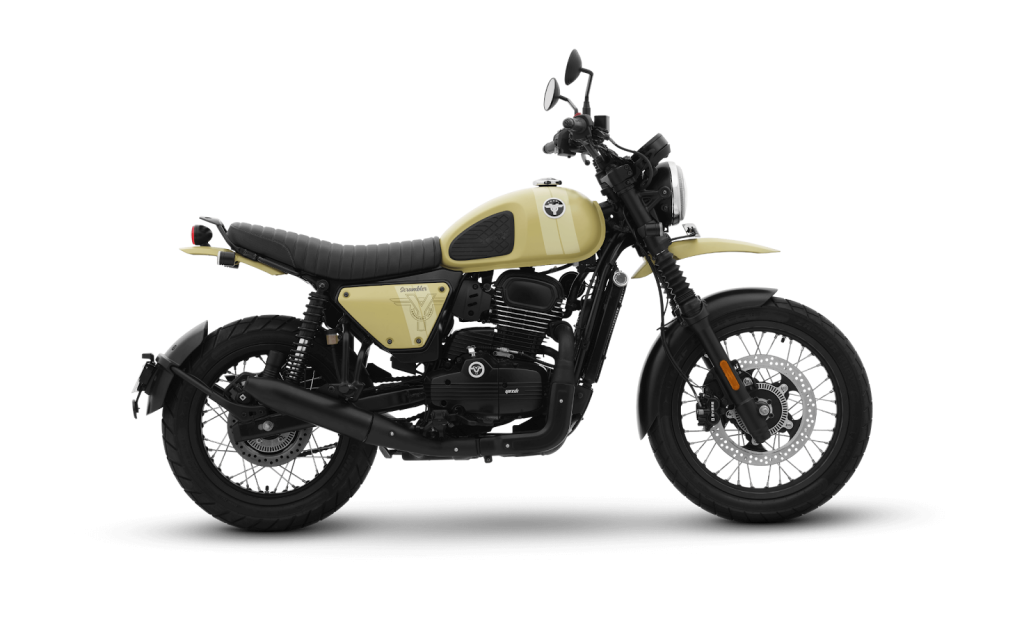
The Yezdi Scrambler is perfect for adventurous souls. It delivers a blend of power and agility, making it an ideal off-road mountain bike for navigating both smooth and rocky terrains.
| Specifications | Details |
| Engine | 334cc, Single Cylinder, Air-cooled |
| Power | 28.7 bhp @ 8,000 rpm |
| Torque | 28.2 Nm @ 6,500 rpm |
| Fuel Tank Capacity | 12 Litres |
| Mileage | 25-30 km/l |
| Front Suspension | Telescopic Fork |
| Rear Suspension | Twin Shock |
| Front Brake | Disc Brake, 280mm |
| Rear Brake | Disc Brake, 240mm |
| Price | Rs. 2.09 Lakh |
4. Yezdi Adventure
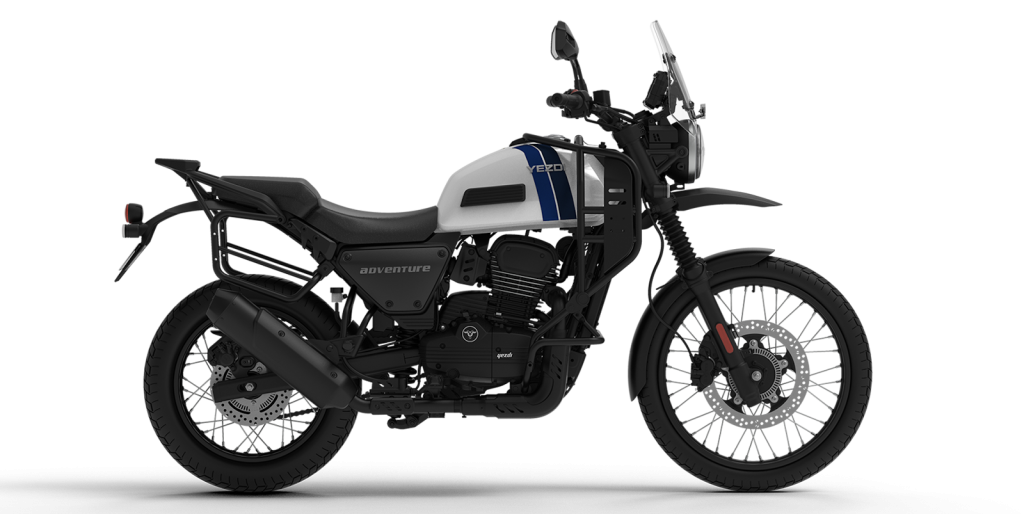
Designed for exploration, the Yezdi Adventure stands out as a top-tier off-road motorcycle. Its performance on rugged trails makes it one of the most trusted off-road bikes in India for those who crave adventure.
| Specifications | Details |
| Engine | 334cc, Single Cylinder, Liquid-cooled |
| Power | 29.1 bhp @ 7,300 rpm |
| Torque | 29.1 Nm @ 6,500 rpm |
| Fuel Tank Capacity | 15.5 Litres |
| Mileage | 25-30 km/l |
| Front Suspension | Telescopic Fork |
| Rear Suspension | Twin Shock |
| Front Brake | Disc Brake, 320mm |
| Rear Brake | Disc Brake, 240mm |
| Price | Rs. 2.09 Lakh |
5. KTM 250 Adventure
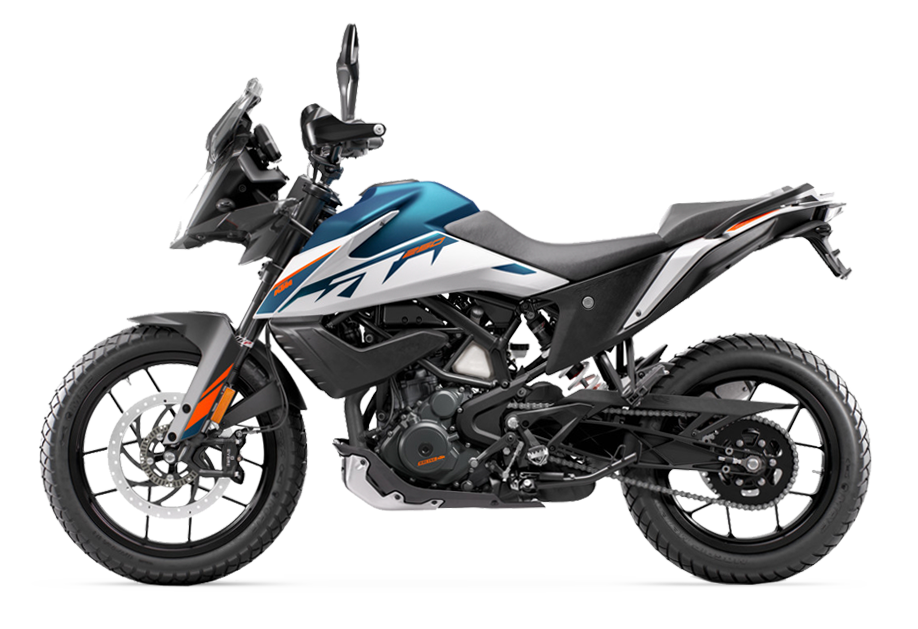
Built for tough terrains, the KTM 250 Adventure is an excellent choice for off-road enthusiasts. It’s one of the best off-road bikes in India for riders looking for a reliable and agile bike that can take on any challenge.
| Specifications | Details |
| Engine | 248.8cc, Single Cylinder, Liquid-cooled |
| Power | 29.6 bhp @ 8,500 rpm |
| Torque | 24 Nm @ 6,500 rpm |
| Fuel Tank Capacity | 14.5 Litres |
| Mileage | 30-35 km/l |
| Front Suspension | WP APEX USD Fork, 43mm |
| Rear Suspension | WP APEX Monoshock |
| Front Brake | Disc Brake, 320mm |
| Rear Brake | Disc Brake, 230mm |
| Price | Rs. 2.40 Lakh |
6. Triumph Scrambler 400 X
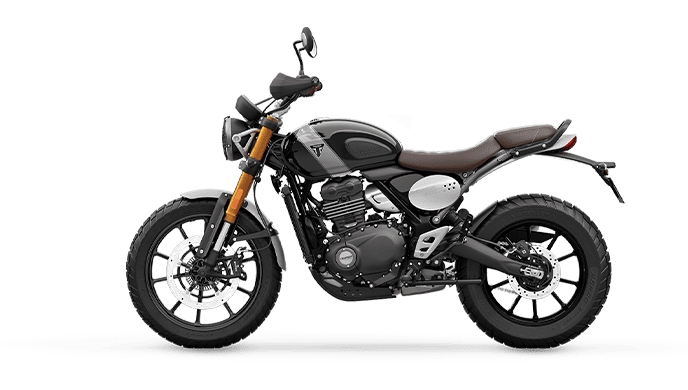
A powerful option for those who enjoy both on-road and off-road adventures, the Triumph Scrambler 400 X is known for its superior suspension and strong performance on rugged trails. If you’re after the best off-road bike, this model delivers exceptional quality and ride comfort.
| Specifications | Details |
| Engine | 398cc, Parallel Twin, Liquid-cooled |
| Power | 39.5 bhp @ 8,000 rpm |
| Torque | 37.6 Nm @ 6,500 rpm |
| Fuel Tank Capacity | 16 Litres |
| Mileage | 20-25 km/l |
| Front Suspension | Showa Telescopic Fork |
| Rear Suspension | Showa Monoshock |
| Front Brake | Disc Brake, 320mm |
| Rear Brake | Disc Brake, 255mm |
| Price | Rs. 5.15 Lakh |
7. KTM 390 Adventure X
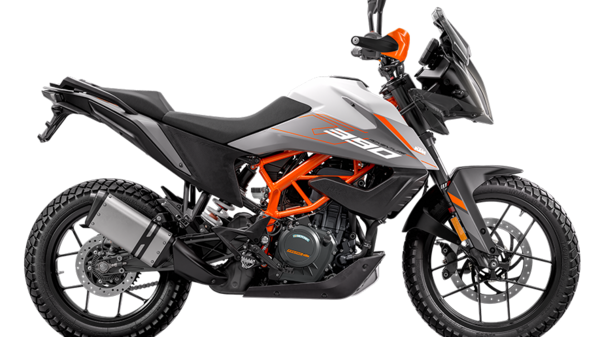
A strong contender in the world of off-road bikes, the KTM 390 Adventure X is designed to take on the toughest trails. It offers great value, especially for those looking for off-road bikes under 2 Lakh.
| Specifications | Details |
| Engine | 373cc, Single Cylinder, Liquid-cooled |
| Power | 43 bhp @ 9,000 rpm |
| Torque | 37 Nm @ 7,000 rpm |
| Fuel Tank Capacity | 14 Litres |
| Mileage | 28-35 km/l |
| Front Suspension | WP APEX USD Fork, 43mm |
| Rear Suspension | WP APEX Monoshock |
| Front Brake | Disc Brake, 320mm |
| Rear Brake | Disc Brake, 230mm |
| Price | Rs. 2.85 Lakh |
8. Royal Enfield Himalayan 450
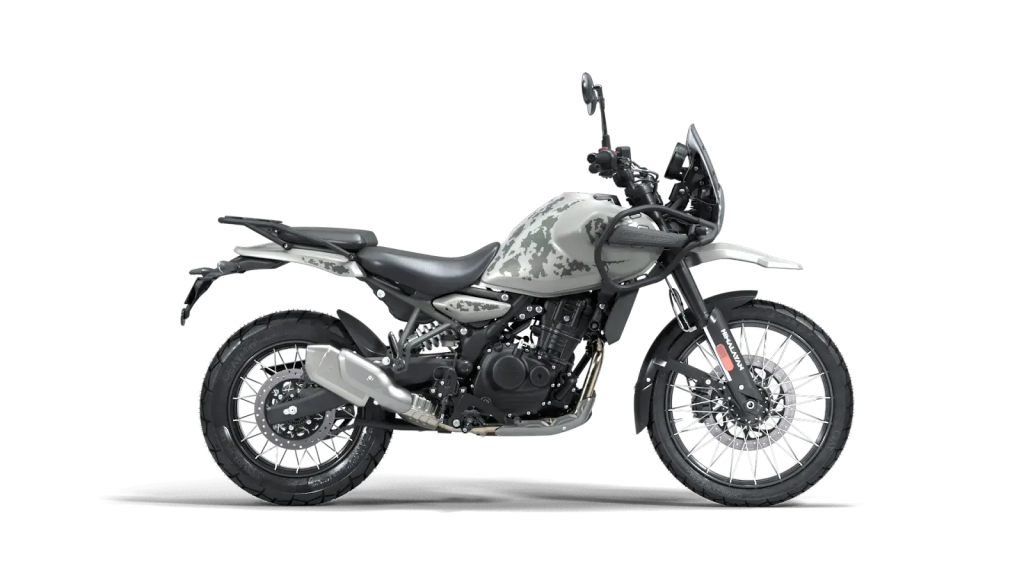
The Himalayan 450 is an iconic bike for off-road enthusiasts, offering comfort and power for long rides. As one of the best off-road bikes in India, it’s perfect for tackling difficult terrain while providing excellent control and stability.
| Specifications | Details |
| Engine | 450cc, Single Cylinder, Liquid-cooled |
| Power | 40 bhp @ 8,000 rpm |
| Torque | 40 Nm @ 6,000 rpm |
| Fuel Tank Capacity | 15 Litres |
| Mileage | 30-35 km/l |
| Front Suspension | Telescopic Fork |
| Rear Suspension | Monoshock |
| Front Brake | Disc Brake, 300mm |
| Rear Brake | Disc Brake, 240mm |
| Price | Rs. 2.90 Lakh |
9. Benelli TRK 251
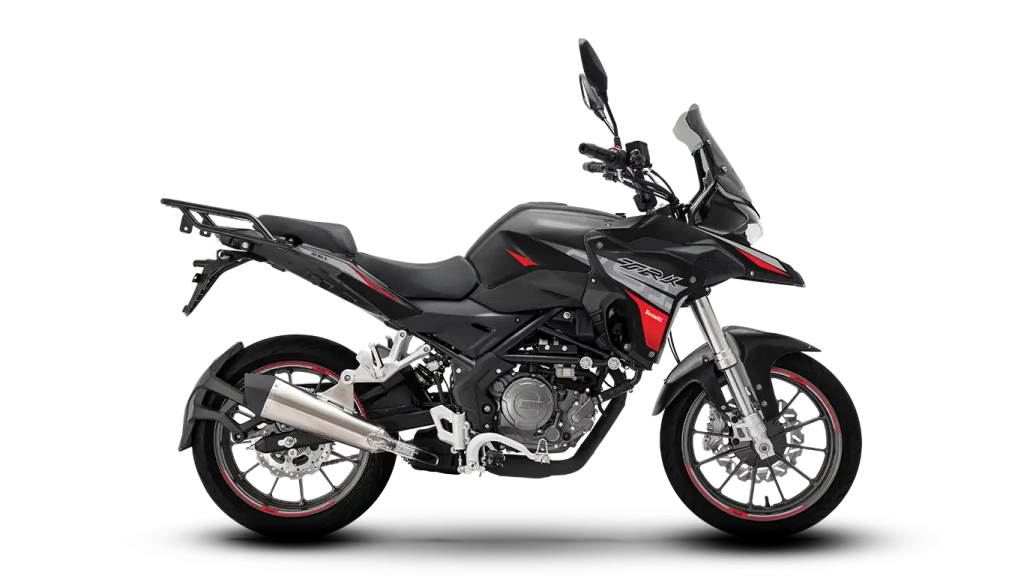
Known for its versatility, the Benelli TRK 251 is an excellent choice for those seeking an all-terrain off-road bike. It combines style and performance for a smooth ride across various landscapes.
| Specifications | Details |
| Engine | 249cc, Single Cylinder, Liquid-cooled |
| Power | 25 bhp @ 9,000 rpm |
| Torque | 21.1 Nm @ 6,500 rpm |
| Fuel Tank Capacity | 18 Litres |
| Mileage | 30-35 km/l |
| Front Suspension | USD Fork |
| Rear Suspension | Mono-shock |
| Front Brake | Disc Brake, 280mm |
| Rear Brake | Disc Brake, 240mm |
| Price | Rs. 2.60 Lakh |
10. BMW G 310 GS
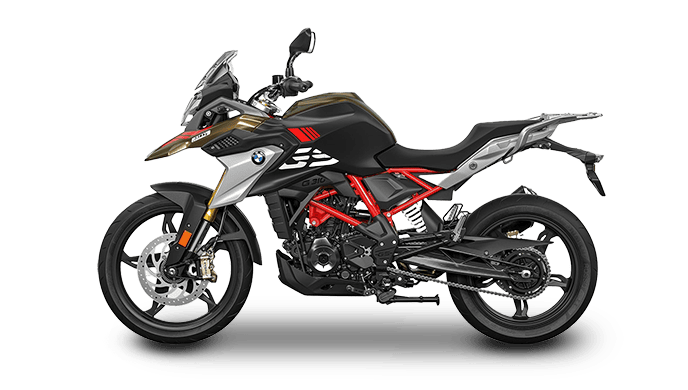
For those looking for premium performance, the BMW G 310 GS delivers unmatched stability on both paved and rugged roads. It’s a standout off-road motorcycle that’s ideal for long-distance and adventure riding.
| Specifications | Details |
| Engine | 313cc, Single Cylinder, Liquid-cooled |
| Power | 34 bhp @ 9,500 rpm |
| Torque | 28 Nm @ 7,500 rpm |
| Fuel Tank Capacity | 11 Litres |
| Mileage | 28-30 km/l |
| Front Suspension | Upside-down Fork, 41mm |
| Rear Suspension | Monoshock |
| Front Brake | Disc Brake, 300mm |
| Rear Brake | Disc Brake, 240mm |
| Price | Rs. 3.10 Lakh |
11. KTM 390 Adventure
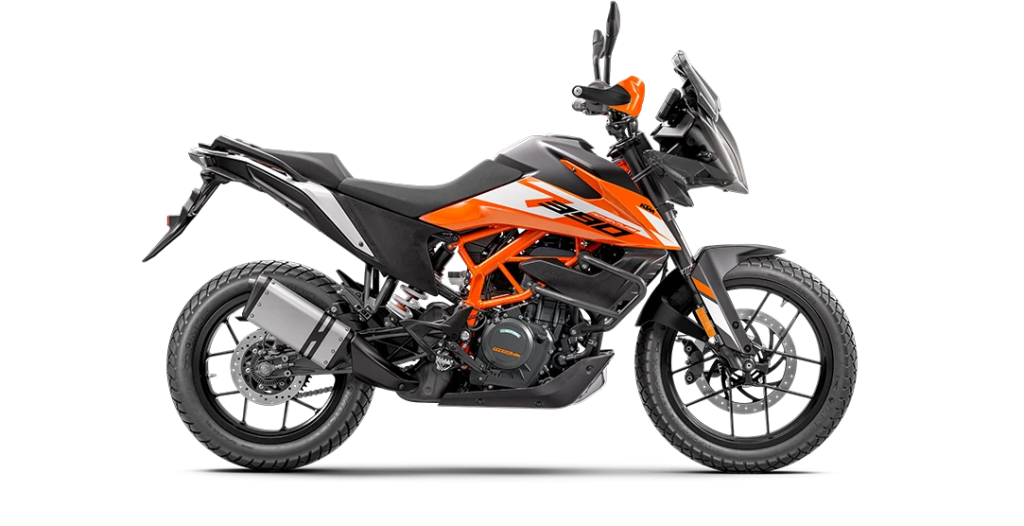
Known for its lightweight build and exceptional suspension system, the KTM 390 Adventure is designed to handle rough trails with ease. A perfect fit for anyone in search of the best off-road bike in India.
| Specifications | Details |
| Engine | 373.2cc, Single Cylinder, Liquid-cooled |
| Power | 43 bhp @ 9,000 rpm |
| Torque | 37 Nm @ 7,000 rpm |
| Fuel Tank Capacity | 14 Litres |
| Mileage | 28-30 km/l |
| Front Suspension | WP APEX 43mm USD Fork |
| Rear Suspension | WP APEX Monoshock |
| Front Brake | Disc Brake, 320mm |
| Rear Brake | Disc Brake, 230mm |
| Price | Rs. 3.30 Lakh |
12. Kawasaki KLX 140
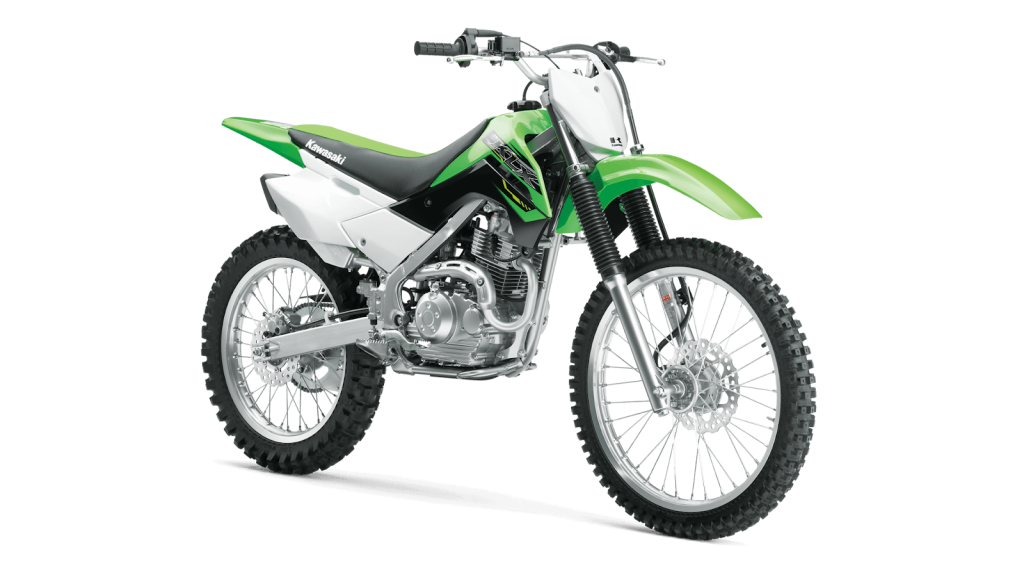
A smaller, more agile option, the Kawasaki KLX 140 is perfect for those who enjoy off-roading bikes that are lightweight and manoeuvrable. It’s a great choice for riders who want a bike that can tackle more technical trails.
| Specifications | Details |
| Engine | 144cc, Single Cylinder, Air-cooled |
| Power | 10 bhp @ 7,500 rpm |
| Torque | 11.3 Nm @ 6,000 rpm |
| Fuel Tank Capacity | 5.8 Litres |
| Mileage | 35-40 km/l |
| Front Suspension | Telescopic Fork |
| Rear Suspension | Twin Shock Absorber |
| Front Brake | Disc Brake, 220mm |
| Rear Brake | Disc Brake, 190mm |
| Price | Rs. 4.20 Lakh |
13. Honda CB500X
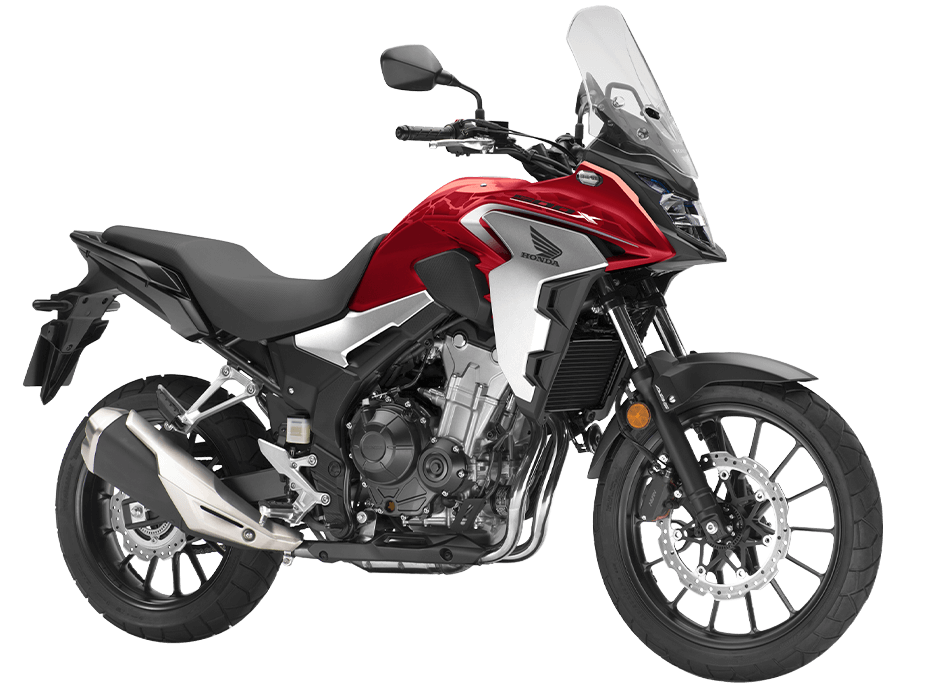
If you’re after a bike that blends off-road capability with road performance, the Honda CB500X is a strong contender. Known for its smooth handling and comfort, it’s an excellent choice for those who love off-roading bikes on long-distance rides.
| Specifications | Details |
| Engine | 471cc, Liquid-cooled, Parallel Twin |
| Power | 47 bhp @ 8,500 rpm |
| Torque | 43 Nm @ 6,500 rpm |
| Fuel Tank Capacity | 17.1 Litres |
| Mileage | 25-30 km/l |
| Front Suspension | 41mm USD Fork |
| Rear Suspension | Monoshock |
| Front Brake | Disc Brake, 296mm |
| Rear Brake | Disc Brake, 220mm |
| Price | Rs. 5.50 Lakh |
14. Kawasaki Versys 650
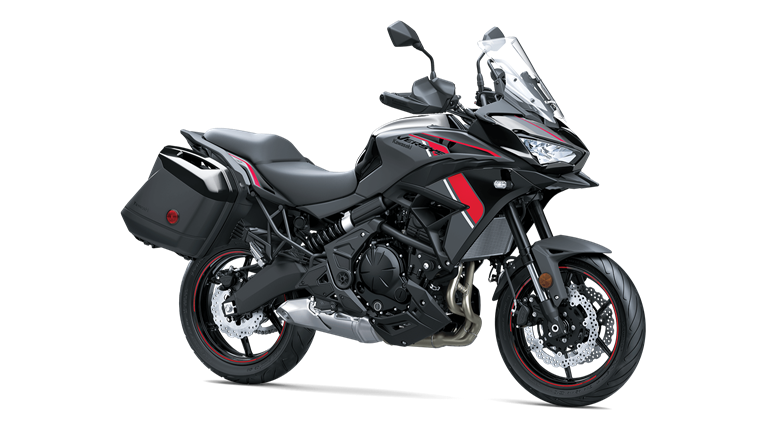
A premium choice for riders who want an adventure-ready bike, the Kawasaki Versys 650 excels in both on-road and off-road conditions. This versatile off-road bike is ideal for tackling diverse terrains.
| Specifications | Details |
| Engine | 649cc, Liquid-cooled, Parallel Twin |
| Power | 68 bhp @ 8,500 rpm |
| Torque | 64 Nm @ 7,000 rpm |
| Fuel Tank Capacity | 21 Litres |
| Mileage | 25-30 km/l |
| Front Suspension | 41mm USD Fork |
| Rear Suspension | Mono-shock |
| Front Brake | Disc Brake, 300mm |
| Rear Brake | Disc Brake, 220mm |
| Price | Rs. 6.00 Lakh |
15. Honda CRF1100L Africa Twin
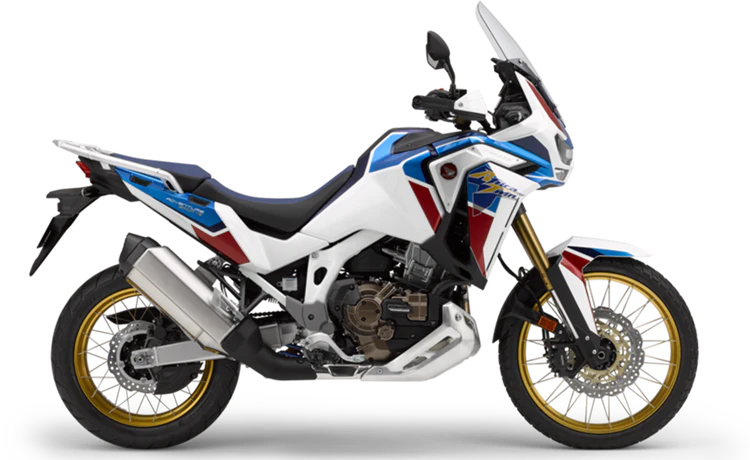
The Honda Africa Twin is built for serious off-roading. With top-tier performance and a reputation for reliability, it’s one of the most durable off-road motorcycles for riders looking to tackle extreme conditions.
| Specifications | Details |
| Engine | 1084cc, Liquid-cooled, Parallel Twin |
| Power | 101 bhp @ 7,500 rpm |
| Torque | 105 Nm @ 6,250 rpm |
| Fuel Tank Capacity | 24.8 Litres |
| Mileage | 20-25 km/l |
| Front Suspension | 45mm USD Fork |
| Rear Suspension | Pro-Link Mono-shock |
| Front Brake | Disc Brake, 310mm |
| Rear Brake | Disc Brake, 256mm |
| Price | Rs. 13.00 Lakh |
16. Triumph Tiger 1200
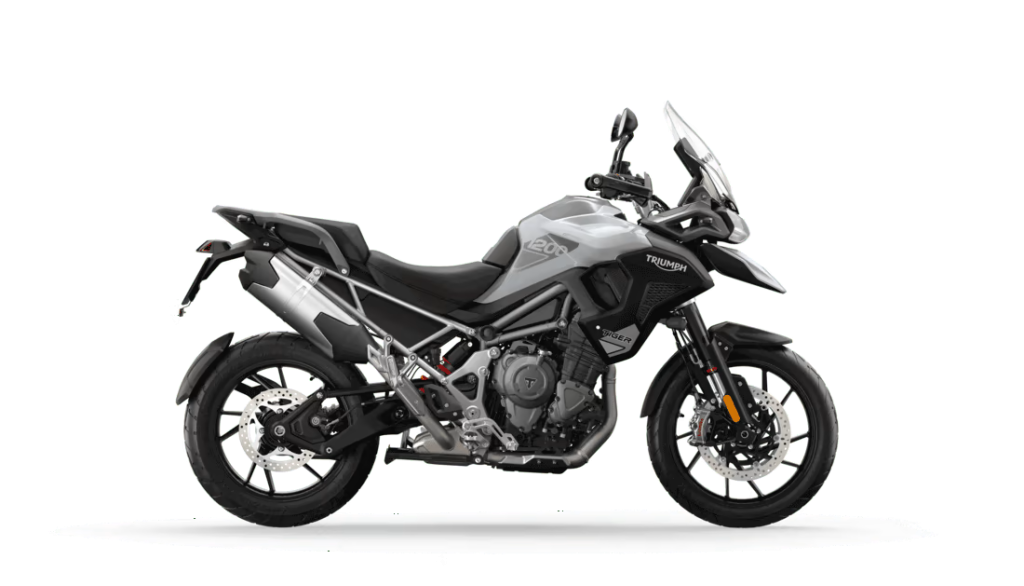
A heavyweight in the world of adventure bikes, the Triumph Tiger 1200 is designed for long-distance riders who want both comfort and power. Known for its exceptional off-road capabilities, it is one of the best off-road bikes for serious adventurers.
| Specifications | Details |
| Engine | 1,160cc, Liquid-cooled, Inline Triple |
| Power | 146 bhp @ 9,000 rpm |
| Torque | 130 Nm @ 7,000 rpm |
| Fuel Tank Capacity | 20 Litres |
| Mileage | 18-22 km/l |
| Front Suspension | Showa 49mm USD Fork |
| Rear Suspension | Showa Twin Shock |
| Front Brake | Dual Disc, 320mm |
| Rear Brake | Disc Brake, 282mm |
| Price | Rs. 18.50 Lakh |
17. BMW R 1300 GS
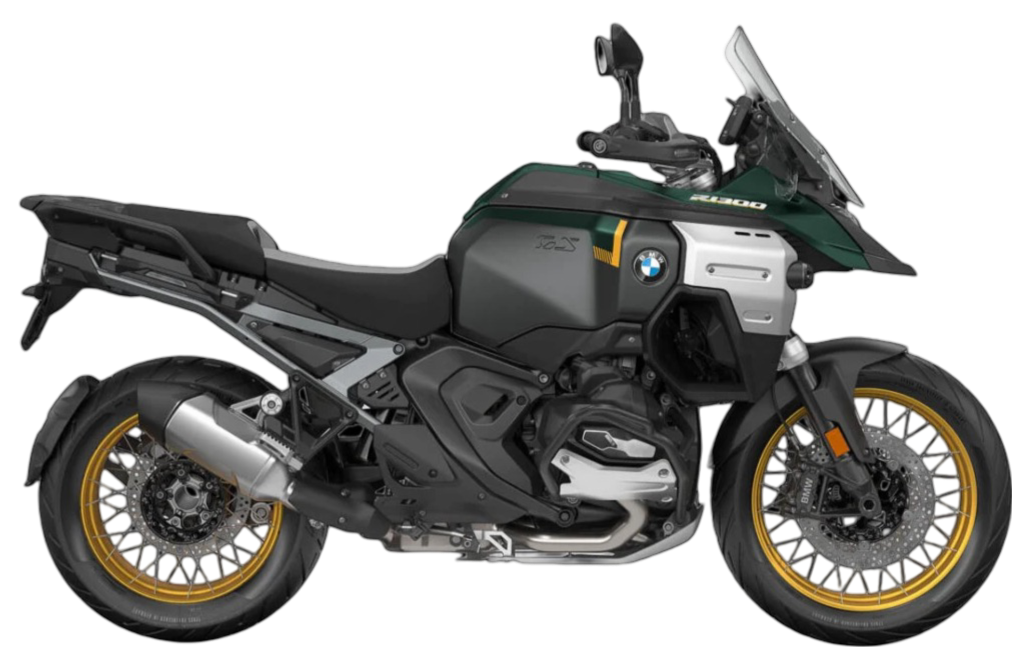
For those who demand the highest quality, the BMW R 1300 GS offers unrivalled power and performance. It’s the best off-road bike for riders who want to dominate challenging terrains while enjoying a premium experience.
| Specifications | Details |
| Engine | 1,301cc, Liquid-cooled, Inline 6 |
| Power | 136 bhp @ 7,750 rpm |
| Torque | 143 Nm @ 6,500 rpm |
| Fuel Tank Capacity | 20 Litres |
| Mileage | 18-22 km/l |
| Front Suspension | Telelever USD Fork |
| Rear Suspension | Paralever Monoshock |
| Front Brake | Dual Disc, 320mm |
| Rear Brake | Disc Brake, 276mm |
| Price | Rs. 22.70 Lakh |
18. Ducati Multistrada
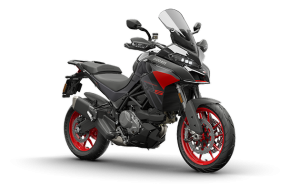
The Ducati Multistrada V4 is a powerful and versatile bike that excels both on and off the road. With its cutting-edge technology, it ranks among the best off-road bikes in India for riders who want to easily tackle everything from smooth highways to challenging trails.
| Specifications | Details |
| Engine | 1,158cc, Liquid-cooled, V-Twin |
| Power | 157 bhp @ 9,500 rpm |
| Torque | 128 Nm @ 7,500 rpm |
| Fuel Tank Capacity | 22 Litres |
| Mileage | 18-22 km/l |
| Front Suspension | Öhlins USD Fork |
| Rear Suspension | Öhlins Twin Shock |
| Front Brake | Dual Disc, 330mm |
| Rear Brake | Disc Brake, 265mm |
| Price | Rs. 21.70 Lakh |
Must Read: Top 26 Bajaj Bikes Price List in India
Conclusion
The off-road bikes listed above are among the top choices in India for 2025, offering outstanding performance, reliability, and value for money. Designed to handle rugged terrains—from rocky trails to muddy paths—they are perfect for adventure enthusiasts. Whether you’re an experienced rider or a beginner, these bikes meet a variety of needs. However, buying an off-road bike can be a significant investment. A Two-Wheeler Loan from Muthoot Capital can help you buy your dream bike without financial constraints. It comes with flexible repayment options, low interest rates, and quick approvals to make your purchase more manageable and stress-free.
FAQs
What is the best off-road bike in India for 2025?
The best off-road bikes in India for 2025 include models like the KTM off-road bike, Hero XPulse 200, and Royal Enfield Himalayan. These bikes offer a great mix of power, durability, and performance.
Which off-road bikes are under 2 Lakh in India?
Some of the best off-road bikes under 2 Lakh in India include the Hero XPulse 200, KTM Duke 200, and the Yamaha FZ-X. These bikes provide excellent off-roading capabilities while being budget-friendly.
What makes a good off-road bike?
A good off-road bike should have a strong suspension system, durable tyres that can handle rough terrains, a powerful engine, and a lightweight design for easy manoeuvrability.
Can I use regular bike tyres for off-roading?
No, regular bike tyres are not suitable for off-road biking. Off-road bikes require off-road bike tyres, which are designed with deeper treads and stronger materials to provide better traction, grip, and durability on rough surfaces like mud, rocks, and gravel.
How much does an off-road bike cost in India?
The off-road bike price in India varies depending on the brand and model. Entry-level bikes like the Hero XPulse 200 can cost around Rs. 1.2 Lakh, while high-end models like the KTM off-road bike can range between Rs. 2 Lakh and Rs. 3 Lakh.
Is off-roading safe?
Off-roading can be a thrilling experience, but it does come with its risks. It’s important to wear proper protective gear, including a helmet, gloves, and knee guards. Additionally, choosing the right off-road bike suited to your skill level and the terrain can enhance your safety.
Are there financing options for buying an off-road bike in India?
Yes, many financial institutions offer bike loans specifically for purchasing off-road bikes. You can explore financing options from NBFCs, such as Muthoot Capital, to avail quick loans with minimal documentation and reasonable interest rates.
Can off-road bikes be used on highways?
Yes, many off-road bikes, especially models like the Royal Enfield Himalayan, are designed for both off-road and on-road use. However, you may need to make modifications for better road performance if you plan to use it primarily on highways.
Trending Post
- Top Ktm Bikes In India With Price And Specifications
- Best Touring Bikes For Long Rides In India
- High-Performance Adventure Bikes For Indian Roads
- High-Mileage Bikes With Best Features For Indian Roads
Categories
Need Help?
Please feel free to contact us on toll free number or send us your query on our email.




